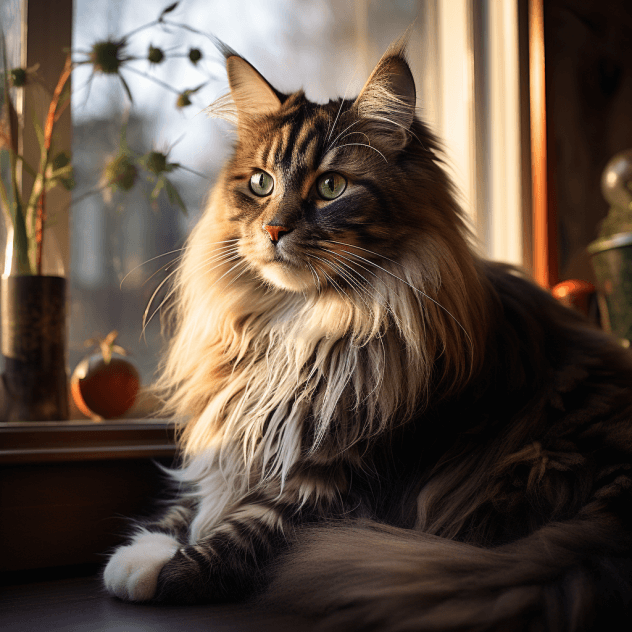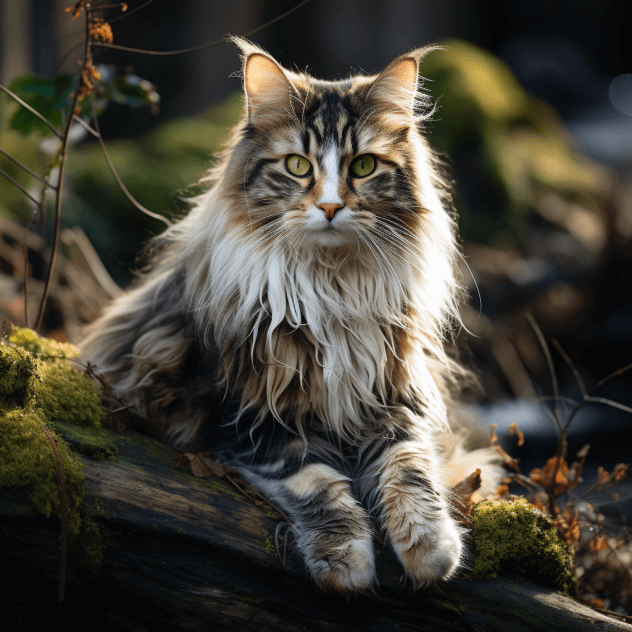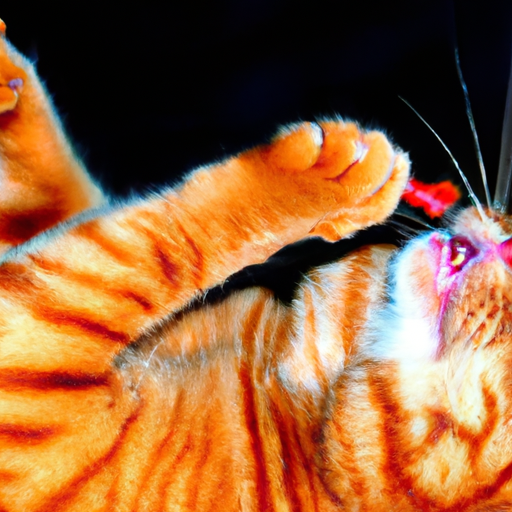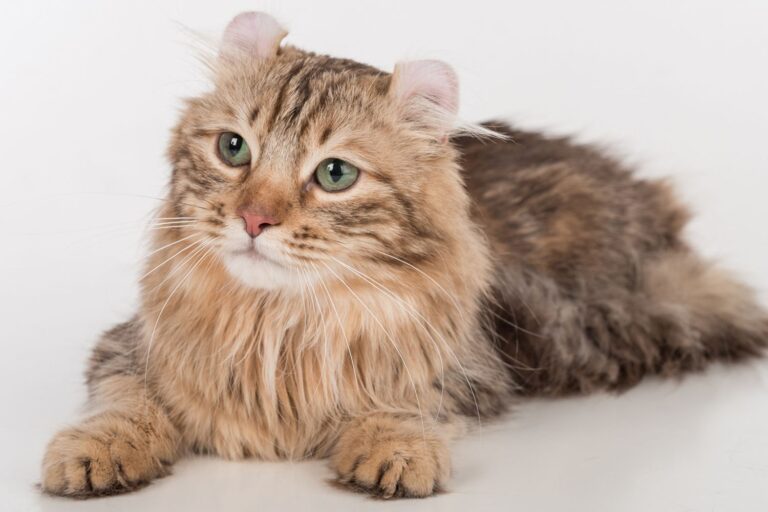Norwegian Forest Cat
The Norwegian Forest Cat: A Large, Friendly Feline Adapted to the Cold
With their long, thick coat and large sturdy build, Norwegian Forest Cats are uniquely adapted to withstand cold climates. This natural breed originated in the snowy Scandinavian region and makes an affectionate and lively pet.The Norwegian Forest Cat is a fluffy, large cat breed believed to have originated as a landrace adapted to Norway’s rugged climate over many centuries. They are recognized for their long, water-resistant fur coat, muscular build, and friendly personality.
Origins as a Landrace Breed
- Native to Norway, existing for centuries before formal breeding
- Descended from cats used by Vikings on ships and farms
- Uniquely adapted for cold winters and rugged terrain
- Achieved breed recognition in the 1970s
- Named the national cat of Norway in 2003
Through natural selection in the harsh Scandinavian environment, the Norwegian Forest Cat developed into a cold-tolerant landrace breed.
Distinctive Physical Features
The Norwegian Forest Cat has several distinguishing features:
- Large, muscular body with sturdy legs
- Long, thick fur with water-repellent top layer
- Full ruff of fur around neck for added insulation
- Long, bushy tail to wrap around body
- Tufted paws act like snowshoes in winter
- Triangular-shaped head with alert, large ears
- Green or gold eyes
Their adaptations help them thrive in cold climates and rugged terrain.
Range of Coat Colors
Norwegian Forest Cats exhibit many coat colors:
- Black
- White
- Orange and red
- Brown tabby
- Blue tabby
- Silver tabby
- Tortoiseshell patterns in black, blue and cream
Kittens often have faint stripes that disappear as adults. The thick double coat consists of a wooly underlayer and longer, glossy guard hairs.
Personality and Temperament
This breed is known for its friendly, outgoing personality:
- Intelligent, curious, and observant
- Energetic and playful
- Excellent climbers and hunters
- Affectionate and loyal towards family
- Adaptable to new environments
- Generally good with children and other pets
- Mature slowly, reaching full size around 5 years old
Norwegian Forest Cats form close bonds and enjoy interacting with their human families.
Care and Health Considerations
- Require regular grooming to prevent matting
- Prone to heart conditions like hypertrophic cardiomyopathy
- Sensitive to anesthesia due to their muscle density
- Need lots of exercise and environmental enrichment
- Expected lifespan is 12-16 years
Provide proper preventative veterinary care and grooming for their long coat.

Origin as Natural Outdoor Cats
Due to their natural history as outdoor farm and ship cats, this breed shows behaviors like:
- Excellent hunting skills
- Agility climbing trees and perching up high
- Love playing in water
- Highly adaptable to cold conditions
- Tend to be large and slow to mature
Their rugged background gives them great agility, adaptability, and hunting instinct.
Key Takeaways About the Norwegian Forest Cat
- Originated as a landrace breed adapted to Norway’s climate
- Distinctive for long fur, muscular build, and ruff/tufted paws
- Friendly, energetic personality and strong family bonds
- Range of coat colors, often tabby patterns as kittens
- Require regular grooming and some health considerations
- Make excellent family pets given proper care
The Norwegian Forest Cat’s majestic appearance and friendly personality make them a popular pedigreed breed. Their natural adaptability serves them well as household companions.
What are the key characteristics of the Norwegian Forest Cat breed?
Appearance
- Large, muscular, robust build
- Long, thick, water-resistant fur coat
- Full ruff around neck for insulation
- Long, bushy tail to wrap around body
- Tufted paws act like snowshoes
- Triangular head, large ears, green/gold eyes
Temperament
- Intelligent, curious, observant
- Playful, energetic
- Excellent climber and hunter
- Affectionate, loyal to family
- Adaptable to new environments
- Good with children and other pets
Other Traits
- Originated as a natural breed in Norway
- Used as ship’s cats by Vikings
- Love playing in water
- Slow to mature, reaching full size around 5 years
- Require regular grooming for long fur
- Prone to some heart conditions
In summary, the Norwegian Forest Cat is a large, fluffy breed adapted to cold climates with an outgoing, friendly personality. Their lush coat, strong build, and affectionate nature make them popular pets.
How much grooming do Norwegian Forest Cats require?
- Norwegian Forest Cats have a thick double coat designed to withstand cold weather. Their topcoat consists of long, coarse guard hairs over a soft, dense undercoat.
- These cats shed heavily during spring and summer as the weather warms up. Their coat needs more frequent grooming during shedding seasons to remove loose hair and prevent matting(link).
- A metal comb or slicker brush are ideal tools for grooming their thick coat. Work slowly and gently to avoid pulling on knots. Offer treats during grooming to make it a positive experience(link).
- Grooming 1-2 times per week is usually sufficient during non-shedding periods. Daily grooming may be needed when shedding heavily in spring/summer(link).
- Bathing is rarely needed, only if their fur becomes heavily soiled. Use a cat-safe shampoo and thoroughly dry their thick coat afterwards(link).
- Do not shave a Norwegian Forest Cat. Their coat provides insulation from heat and sun as well. Removing it can lead to sunburn and coat damage(link).
- Pay attention to their hindquarters, belly, behind the ears, and legs, where mats often develop. Carefully work apart any tangles.
- Start grooming kittens young so they become accustomed to the routine. Make it a calm, rewarding experience.
- Outdoor Norwegian Forest Cats may need more frequent grooming to remove debris like dirt, leaves, and burrs from their long fur.
Resources to Learn More
With their lush coat, muscular build, and affectionate nature, the Norwegian Forest Cat is a unique breed cherished by cat lovers worldwide.







